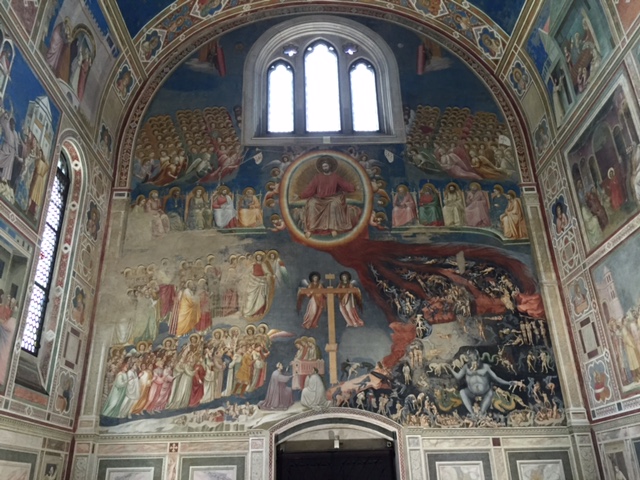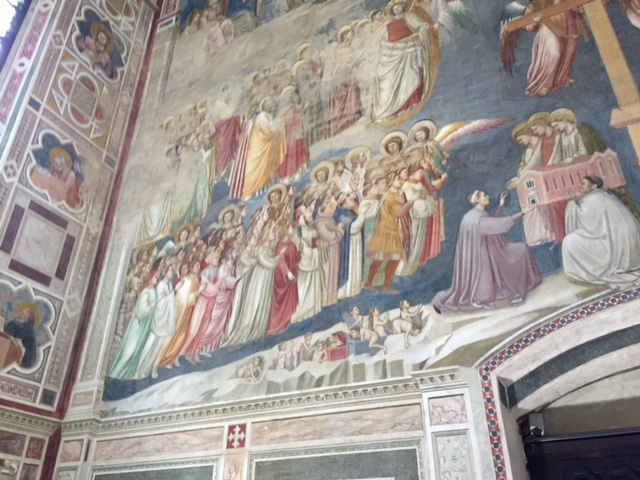Sacred and Profane Images in Venice and Padua
By Bernie Langs
 The laws and edicts are laid out in the Old Testament in exacting terms specifying the ornaments, utensils and measurements for these objects utilized in the holy temple and for the division of spaces designated as sacred from those places for mortals. The biblically assigned priestly caste was left to minister the negotiation between man and God. Only he could physically enter the area behind the curtain or veil beyond the altar separating the congregation from the Holy Spirit.
The laws and edicts are laid out in the Old Testament in exacting terms specifying the ornaments, utensils and measurements for these objects utilized in the holy temple and for the division of spaces designated as sacred from those places for mortals. The biblically assigned priestly caste was left to minister the negotiation between man and God. Only he could physically enter the area behind the curtain or veil beyond the altar separating the congregation from the Holy Spirit.
The Jewish religion prohibits graven images of God, forbidding representational sculptures or paintings of biblical stories and heroes. There are examples of Jewish burial tombs and other remains that had been decorated with the symbols for rituals and life in the ancient world that were later mutilated or chiseled away by disapproving rabbis as a reminder of these edicts. Early Christian images, after co-opting ideas from those previously of service to ancient Roman and Greek gods or from secular life, accelerated into the early medieval time with flourishes of astounding profundity and beauty. Lives were lost over the iconoclast notion that to pictorially represent Christ and the Holy Spirit was a dangerous trespass on the immaculate and omniscient ideal since no picture could or should imitate or approximate the Divine.
At the culmination of the middle ages and into the early and High Renaissance there was no holding back the master illuminators, sculptors and painters in Italy and in the northern areas of Europe. Great religious art peters out by the mid-seventeenth century at which time there was no longer room for innovation and the power that such images had previously attained was lost.
Today we live in a time of hyper self-awareness. As many people abandon notions of a God who is aware of mankind’ actions and is capable of direct intervention in human affairs, there remains a void to be filled for a higher purpose in life. From some perspectives, a desirable end of ritualistic and avid dogmatic doctrine might relieve a great deal of worldly tensions since fanatics and zealots hold strong so-called inspired revelations. Equally profound and illuminating might be a more objective and scientific study of those in the past who, in the written word or through the plastic arts, drew inspiration on the notions and ideas of their times of what was holy and greater than human endeavor. Some might find interest in a religion that reluctantly winks at the thought of a Primary Mover and nothing else, yet still finds fascination in what was revealed by others who had taken a different, mystical path as they groped for understanding a higher purpose.
I was recently in the ethereal city of Venice and found time to visit Padua on a day trip. I decided that I did not need sanctioned Priest to lift the veil of bygone mystery, since such an idea is metaphoric at best. To see Titian’s painting The Assumption of the Virgin above the altar where it has hovered for hundreds of years was but one example of sublime moments of unreal vision. Mary rises towards the heavens and Titian’s notion of what that entails is open to all interpretations. Below the earth-bound, beautifully rendered crowd of Apostles move and dance in graceful wonder.
Tintoretto’s many paintings from the 1500s in the Scuola di San Rocco also left me in awe and breathless. There are dozens of massive works on the walls and two ceilings of the gallery giving the eye multiple places to look as one sways in blissful dizziness. The apex is found in a large side room with an entire wall depicting a massive scene of the Crucifixion, which I experienced as a series of planar rectangles bouncing and folding out in various impossible directions and dimensions. The elegantly painted blues and reds, and the soft palate of the master leaves one knowing that mankind is capable of the most subtle ideas of beauty and grace.
In Padua, I was treated to viewing the rare fine wine of fourteenth century frescos in the Basilica of Saint Anthony, the Oratorio di San Giorgio, and the Arena Chapel. I stood in the large chapel of the Oratorio with just two other amazed tourists and took in the wall painting rendered by pupils of the greatest Early Renaissance master, Giotto. At the Arena Chapel frescoed by Giotto, I can hardly describe the aura of sublime artistic wonder that the master evokes, especially in his wall sized depiction of The Last Judgment. Giotto’s achievement is the height of both technical and mystical genius. The art pops off the walls at the viewer and there is much to feast on for soulful edification. Giotto helped usher in humanism and the Renaissance spirit and his paintings gave the world a quantum leap in depicting spiritual ideas and human and so-called divine emotions. By the time Veronese, Bellini, Carpaccio, Tintoretto and Titian were painting in Venice two hundred years later, their figures displayed the most subtle of physical characteristics and in the expressions of their men, women, saints, and ancient gods, one can sense the very ideas stirring within them.
Titian is again found in the main museum of Venice, L’Accademia. In his late painting on the meditation of the dead Christ, he is found in self-portrait as Saint Jerome who gently holds the hand of the impressionistically rendered avatar. I wondered if Titian is almost pleading for spiritual guidance as he ponders his own impending demise. One leaves the museum viewing Titian’s wall-sized depiction of The Presentation of the Virgin where Mary rises up a stone stairway towards the Temple where an imposing bearded priest awaits.
 The problem with lifting the allegorical veil to study the mindset of the mystic painters of the wild Freudian Id is that it is at times not easy to close the door again from the rush of ideas and possibilities. And I awoke in my bed in the hotel just outside Venice, half awake, half asleep, and I gently swayed as if sailing on a canal and from the corner of my eye I could see high above the spiritual cauldron of yore and of Idea, generating the cloud images offered by the imaginations of those who’d come before. As I returned to slumber, I imagined I could hear a gentle and profound word or two of encouragement and perhaps approval uttered by the Conscript Fathers or maybe even by the spirit of the Doges and his Magistrates themselves.
The problem with lifting the allegorical veil to study the mindset of the mystic painters of the wild Freudian Id is that it is at times not easy to close the door again from the rush of ideas and possibilities. And I awoke in my bed in the hotel just outside Venice, half awake, half asleep, and I gently swayed as if sailing on a canal and from the corner of my eye I could see high above the spiritual cauldron of yore and of Idea, generating the cloud images offered by the imaginations of those who’d come before. As I returned to slumber, I imagined I could hear a gentle and profound word or two of encouragement and perhaps approval uttered by the Conscript Fathers or maybe even by the spirit of the Doges and his Magistrates themselves.
